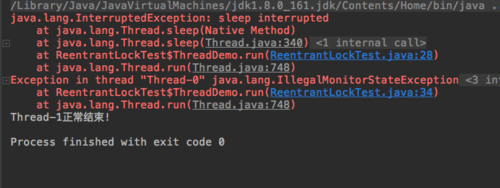1. ReentrantLock简介
jdk中独占锁的实现除了使用关键字synchronized外,还可以使用ReentrantLock。虽然在性能上ReentrantLock和synchronized没有什么区别,但ReentrantLock相比synchronized而言功能更加丰富,使用起来更为灵活,也更适合复杂的并发场景。
2. ReentrantLock和synchronized的相同点
2.1 ReentrantLock是独占锁且可重入的
例子
public class ReentrantLockTest { public static void main(String[] args) throws InterruptedException {
ReentrantLock lock = new ReentrantLock(); for (int i = 1; i <= 3; i++) { lock.lock();
} for(int i=1;i<=3;i++){ try {
} finally { lock.unlock();
}
}
}
}上面的代码通过lock()方法先获取锁三次,然后通过unlock()方法释放锁3次,程序可以正常退出。从上面的例子可以看出,ReentrantLock是可以重入的锁,当一个线程获取锁时,还可以接着重复获取多次。在加上ReentrantLock的的独占性,我们可以得出以下ReentrantLock和synchronized的相同点。
1.ReentrantLock和synchronized都是独占锁,只允许线程互斥的访问临界区。但是实现上两者不同:synchronized加锁解锁的过程是隐式的,用户不用手动操作,优点是操作简单,但显得不够灵活。一般并发场景使用synchronized的就够了;ReentrantLock需要手动加锁和解锁,且解锁的操作尽量要放在finally代码块中,保证线程正确释放锁。ReentrantLock操作较为复杂,但是因为可以手动控制加锁和解锁过程,在复杂的并发场景中能派上用场。
2.ReentrantLock和synchronized都是可重入的。synchronized因为可重入因此可以放在被递归执行的方法上,且不用担心线程最后能否正确释放锁;而ReentrantLock在重入时要却确保重复获取锁的次数必须和重复释放锁的次数一样,否则可能导致其他线程无法获得该锁。
2. ReentrantLock相比synchronized的额外功能
2.1 ReentrantLock可以实现公平锁。
公平锁是指当锁可用时,在锁上等待时间最长的线程将获得锁的使用权。而非公平锁则随机分配这种使用权。和synchronized一样,默认的ReentrantLock实现是非公平锁,因为相比公平锁,非公平锁性能更好。当然公平锁能防止饥饿,某些情况下也很有用。在创建ReentrantLock的时候通过传进参数true创建公平锁,如果传入的是false或没传参数则创建的是非公平锁
ReentrantLock lock = new ReentrantLock(true);
继续跟进看下源码
/**
* Creates an instance of {@code ReentrantLock} with the
* given fairness policy.
*
* @param fair {@code true} if this lock should use a fair ordering policy
*/public ReentrantLock(boolean fair) {
sync = fair ? new FairSync() : new NonfairSync();
}可以看到公平锁和非公平锁的实现关键在于成员变量sync的实现不同,这是锁实现互斥同步的核心。以后有机会我们再细讲。
一个公平锁的例子
public class ReentrantLockTest { static Lock lock = new ReentrantLock(true); public static void main(String[] args) throws InterruptedException { for(int i=0;i<5;i++){ new Thread(new ThreadDemo(i)).start();
}
} static class ThreadDemo implements Runnable {
Integer id; public ThreadDemo(Integer id) { this.id = id;
}
@Override public void run() { try {
TimeUnit.MILLISECONDS.sleep(10);
} catch (InterruptedException e) {
e.printStackTrace();
} for(int i=0;i<2;i++){ lock.lock();
System.out.println("获得锁的线程:"+id); lock.unlock();
}
}
}
}公平锁结果

我们开启5个线程,让每个线程都获取释放锁两次。为了能更好的观察到结果,在每次获取锁前让线程休眠10毫秒。可以看到线程几乎是轮流的获取到了锁。如果我们改成非公平锁,再看下结果
非公平锁结果

线程会重复获取锁。如果申请获取锁的线程足够多,那么可能会造成某些线程长时间得不到锁。这就是非公平锁的“饥饿”问题。
公平锁和非公平锁该如何选择
大部分情况下我们使用非公平锁,因为其性能比公平锁好很多。但是公平锁能够避免线程饥饿,某些情况下也很有用。
2.2 .ReentrantLock可中断响应
当使用synchronized实现锁时,阻塞在锁上的线程除非获得锁否则将一直等待下去,也就是说这种无限等待获取锁的行为无法被中断。而ReentrantLock给我们提供了一个可以响应中断的获取锁的方法lockInterruptibly()。该方法可以用来解决死锁问题。
响应中断的例子
public class ReentrantLockTest { static Lock lock1 = new ReentrantLock(); static Lock lock2 = new ReentrantLock(); public static void main(String[] args) throws InterruptedException {
Thread thread = new Thread(new ThreadDemo(lock1, lock2));//该线程先获取锁1,再获取锁2
Thread thread1 = new Thread(new ThreadDemo(lock2, lock1));//该线程先获取锁2,再获取锁1
thread.start();
thread1.start();
thread.interrupt();//是第一个线程中断
} static class ThreadDemo implements Runnable {
Lock firstLock;
Lock secondLock; public ThreadDemo(Lock firstLock, Lock secondLock) { this.firstLock = firstLock; this.secondLock = secondLock;
} @Override
public void run() { try {
firstLock.lockInterruptibly();
TimeUnit.MILLISECONDS.sleep(10);//更好的触发死锁
secondLock.lockInterruptibly();
} catch (InterruptedException e) {
e.printStackTrace();
} finally {
firstLock.unlock();
secondLock.unlock();
System.out.println(Thread.currentThread().getName()+"正常结束!");
}
}
}
}结果

构造死锁场景:创建两个子线程,子线程在运行时会分别尝试获取两把锁。其中一个线程先获取锁1在获取锁2,另一个线程正好相反。如果没有外界中断,该程序将处于死锁状态永远无法停止。我们通过使其中一个线程中断,来结束线程间毫无意义的等待。被中断的线程将抛出异常,而另一个线程将能获取锁后正常结束。
2.3 获取锁时限时等待
ReentrantLock还给我们提供了获取锁限时等待的方法tryLock(),可以选择传入时间参数,表示等待指定的时间,无参则表示立即返回锁申请的结果:true表示获取锁成功,false表示获取锁失败。我们可以使用该方法配合失败重试机制来更好的解决死锁问题。
更好的解决死锁的例子
public class ReentrantLockTest { static Lock lock1 = new ReentrantLock(); static Lock lock2 = new ReentrantLock(); public static void main(String[] args) throws InterruptedException {
Thread thread = new Thread(new ThreadDemo(lock1, lock2));//该线程先获取锁1,再获取锁2
Thread thread1 = new Thread(new ThreadDemo(lock2, lock1));//该线程先获取锁2,再获取锁1
thread.start();
thread1.start();
} static class ThreadDemo implements Runnable {
Lock firstLock;
Lock secondLock; public ThreadDemo(Lock firstLock, Lock secondLock) { this.firstLock = firstLock; this.secondLock = secondLock;
} @Override
public void run() { try { while(!lock1.tryLock()){
TimeUnit.MILLISECONDS.sleep(10);
} while(!lock2.tryLock()){
lock1.unlock();
TimeUnit.MILLISECONDS.sleep(10);
}
} catch (InterruptedException e) {
e.printStackTrace();
} finally {
firstLock.unlock();
secondLock.unlock();
System.out.println(Thread.currentThread().getName()+"正常结束!");
}
}
}
}结果

线程通过调用tryLock()方法获取锁,第一次获取锁失败时会休眠10毫秒,然后重新获取,直到获取成功。第二次获取失败时,首先会释放第一把锁,再休眠10毫秒,然后重试直到成功为止。线程获取第二把锁失败时将会释放第一把锁,这是解决死锁问题的关键,避免了两个线程分别持有一把锁然后相互请求另一把锁。
3. 结合Condition实现等待通知机制
使用synchronized结合Object上的wait和notify方法可以实现线程间的等待通知机制。ReentrantLock结合Condition接口同样可以实现这个功能。而且相比前者使用起来更清晰也更简单。
3.1 Condition使用简介
Condition由ReentrantLock对象创建,并且可以同时创建多个
static Condition notEmpty = lock.newCondition();static Condition notFull = lock.newCondition();
Condition接口在使用前必须先调用ReentrantLock的lock()方法获得锁。之后调用Condition接口的await()将释放锁,并且在该Condition上等待,直到有其他线程调用Condition的signal()方法唤醒线程。使用方式和wait,notify类似。
一个使用condition的简单例子
public class ConditionTest { static ReentrantLock lock = new ReentrantLock(); static Condition condition = lock.newCondition(); public static void main(String[] args) throws InterruptedException { lock.lock(); new Thread(new SignalThread()).start();
System.out.println("主线程等待通知"); try {
condition.await();
} finally { lock.unlock();
}
System.out.println("主线程恢复运行");
} static class SignalThread implements Runnable {
@Override public void run() { lock.lock(); try {
condition.signal();
System.out.println("子线程通知");
} finally { lock.unlock();
}
}
}
}运行结果

3.2 使用Condition实现简单的阻塞队列
阻塞队列是一种特殊的先进先出队列,它有以下几个特点
1.入队和出队线程安全
2.当队列满时,入队线程会被阻塞;当队列为空时,出队线程会被阻塞。
阻塞队列的简单实现
public class MyBlockingQueue<E> { int size;//阻塞队列最大容量
ReentrantLock lock = new ReentrantLock();
LinkedList<E> list=new LinkedList<>();//队列底层实现
Condition notFull = lock.newCondition();//队列满时的等待条件
Condition notEmpty = lock.newCondition();//队列空时的等待条件
public MyBlockingQueue(int size) { this.size = size;
} public void enqueue(E e) throws InterruptedException {
lock.lock(); try { while (list.size() ==size)//队列已满,在notFull条件上等待
notFull.await(); list.add(e);//入队:加入链表末尾
System.out.println("入队:" +e);
notEmpty.signal(); //通知在notEmpty条件上等待的线程
} finally {
lock.unlock();
}
} public E dequeue() throws InterruptedException {
E e;
lock.lock(); try { while (list.size() == 0)//队列为空,在notEmpty条件上等待
notEmpty.await();
e = list.removeFirst();//出队:移除链表首元素
System.out.println("出队:"+e);
notFull.signal();//通知在notFull条件上等待的线程
return e;
} finally {
lock.unlock();
}
}
}测试代码
public static void main(String[] args) throws InterruptedException {
MyBlockingQueue<Integer> queue = new MyBlockingQueue<>(2); for (int i = 0; i < 10; i++) { int data = i; new Thread(new Runnable() {
@Override public void run() { try { queue.enqueue(data);
} catch (InterruptedException e) {
}
}
}).start();
} for(int i=0;i<10;i++){ new Thread(new Runnable() {
@Override public void run() { try {
Integer data = queue.dequeue();
} catch (InterruptedException e) {
e.printStackTrace();
}
}
}).start();
}
}运行结果

4. 总结
ReentrantLock是可重入的独占锁。比起synchronized功能更加丰富,支持公平锁实现,支持中断响应以及限时等待等等。可以配合一个或多个Condition条件方便的实现等待通知机制。

 随时随地看视频
随时随地看视频




